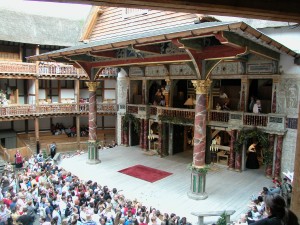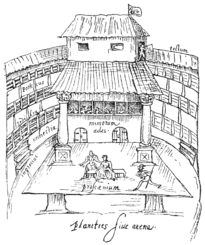 During the Elizabethan period of English history, theaters gained prominence and a greater role within the culture. Before this time, traveling actors were considered little better than thieves and vagrants. In 1572, acting was recognized as a lawful profession. Theater companies were required to be licensed. By 1574, theaters and companies were brought under the purview of the Master of Revels, who also had to approve all plays for performance.
During the Elizabethan period of English history, theaters gained prominence and a greater role within the culture. Before this time, traveling actors were considered little better than thieves and vagrants. In 1572, acting was recognized as a lawful profession. Theater companies were required to be licensed. By 1574, theaters and companies were brought under the purview of the Master of Revels, who also had to approve all plays for performance.
In order to receive a license, theater companies had to have the patronage of a nobleman. The troupe then took the name of its patron. The Lord Chamberlain’s Men, the company associated with Shakespeare, changed its name to The King’s Men after its patron, James VI of Scotland, succeeded Elizabeth to the English throne in 1603.
Acting troupes contained between ten and twenty members, divided between shareholding main members who were paid wages and divided some profits and contracted workers who could serve as extras onstage or as skilled workmen backstage. Apprentices to the companies were boys aged 14 and older. These apprentices received training in theater craft and played the parts of children and women. Once they completed their training, they could hire on with a troupe permanently or seek other employment. The playwright, a key and usually shareholding member of a troupe, would craft parts based on the strengths and capabilities of the men in the troupe.
Playwrights were expected to produce several works during a season. They assisted during rehearsals of their plays, making them directors of a sort. Troupes had to receive permission from the Master of Revels before a play could be offered in performance. Actors received copies of their lines with cues supplied. A summary of entrances, exits, and a general plot were posted backstage for reference during the performance, while a master kept a copy of the entire play, with additional notations about props, scene changes, and cues for musicians and stagehands.
Two types of playhouses existed during the Elizabethan era. Some were small, interior stages, usually in private buildings, which could be lit by candles for evening performances. Although anyone potentially could buy a ticket to a play at one of these theaters, only privileged groups usually did, leading these theaters to be labeled “private.” The more popular and well-known theaters were the large public theaters built on the outskirts of London (and therefore not subject to the city’s stringent laws). At least nine of these playhouses were active during the Elizabethan era, including The Theater, The Curtain, Newington Butts, The Rose (made famous by the film Shakespeare in Love), The Swan, The Fortune, The Red Bull, The Hope, and of course, The Globe, the playhouse most closely associated with Shakespeare. These theaters presented a series of plays in repertory during a season, with less-popular plays being canceled and newer ones being commissioned to take their places. Performances were held often, the exceptions being special holidays, certain days within the church calendar, and at times of plague or widespread sickness. Theaters indicated a performance was being held that day by flying a flag from the roof.
Public playhouses came in varying shapes (round, oval, octagonal, square), and all were open-air, necessitating afternoon performances. The central space, called the pit or yard, was used for general admission. Playgoers could usually get in for a penny to stand on the ground; these “groundlings” were largely uneducated, so playwrights would tailor portions of the play–usually bawdy jokes and physical slapstick–to suit them. Patrons could pay additional money to be seated in one of the galleries within the walls of the theater. Noble patrons were often granted seats in private boxes, some overlooking the stage itself. Playwrights catered to these patrons as well by inserting songs, poetry, and political and noble intrigue within the plot.
 The stage itself was a raised platform four to six feet above ground level, extending into the pit area. To its rear was a multilevel facade with doors that served for entrances and exits with a balcony above. The balcony space could be used to represent a balcony (Romeo and Juliet), castle battlements (Macbeth), or other high places. To the rear was the discovery space, also called the “inner below” for what scholars assume was its location (under the balcony). This space was used to reveal or conceal objects and characters, like Polonius hiding behind the arras in Hamlet or Puck spying on the lovers in A Midsummer Night’s Dream. Because the stage lacked curtains, action was very nearly continuous. Scene and act breaks became more formalized in later years as theater spaces changed.
The stage itself was a raised platform four to six feet above ground level, extending into the pit area. To its rear was a multilevel facade with doors that served for entrances and exits with a balcony above. The balcony space could be used to represent a balcony (Romeo and Juliet), castle battlements (Macbeth), or other high places. To the rear was the discovery space, also called the “inner below” for what scholars assume was its location (under the balcony). This space was used to reveal or conceal objects and characters, like Polonius hiding behind the arras in Hamlet or Puck spying on the lovers in A Midsummer Night’s Dream. Because the stage lacked curtains, action was very nearly continuous. Scene and act breaks became more formalized in later years as theater spaces changed.
Shakespeare’s Globe was first built in 1599, with a reconstruction in 1614 after a fire set during a performance burned the original playhouse to the ground in a matter of hours. The rebuilt theater was closed, as all of the theaters were, by Oliver Cromwell during the English Protectorate (Puritan rule) in 1642 and torn down to accommodate more housing in 1644. In the 1980s, American actor Sam Wanamaker led an international effort to reconstruct The Globe Theatre near its original site in London, and the fully-operational theater reopened for performances in 1997, more than 350 years after the original theater was torn down. Click here for more information on the new Globe, which is pictured above. For a virtual tour of the theater space, click here.
